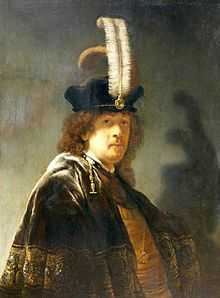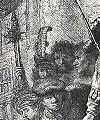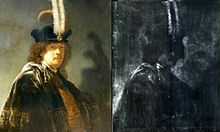Self-portrait wearing a white feathered bonnet
 | |
| Artist | Rembrandt |
|---|---|
| Year | 1635 |
| Type | Oil on (beech) wood |
| Dimensions | 90.5 cm × 71.8 cm (35.6 in × 28.3 in) |
| Location | Buckland Abbey |
Self-portrait wearing a white feathered bonnet is an oil painting attributed to the Dutch painter Rembrandt. It is signed and dated 1635.[1] It was traditionally regarded as a Rembrandt self-portrait until 1968, when it was rejected on stylistic grounds in the Rembrandt catalogue raisonné by Horst Gerson. On 18 March 2013 it was re-attributed to the master by Ernst van de Wetering.
The painting
The self-portrait shows Rembrandt at half length facing towards the right, wearing a velvet cape decorated with gold embroidery over a gorget. A medallion hangs from a gold chain around his neck. He is wearing a black velvet beret shading his eyes and from the front of it, another medallion supports two vertical ostrich feathers.
Provenance
- 1635 - The self-portrait is signed and dated bottom right Rembran(..) / f (three triangular dots) 1635[1]
- 1727 - First recorded in the collection catalogue of Joseph Wenzel I, Prince of Liechtenstein[1]
- Collection Edward Speelman Ltd., London[1]
- 1987 - Sold to Harold Samuel, Baron Samuel of Wych Cross[1]
- 2010 - Donated in September 2010 to the collection of the British National Trust for Places of Historic Interest or Natural Beauty from the estate of the late Edna, Lady Samuel of Wych Cross
- 2010 - Installed in Buckland Abbey, a National Trust site
- 2013 - Visited by Ernst van de Wetering
Attribution
The accreditation of this work to Rembrandt was never disputed until Gerson's rejection solely based on stylistic grounds. The Rembrandt Research Project came into being in order to confirm or deny such claims of rejection or attribution by using forensic and historical evidence. According to Ernst van de Wetering, who was on Gerson's team in 1968, he still shares their original concerns about the painting, but the attribution to Rembrandt can be made with much more certainty today based both on historical grounds and x-ray evidence.[2][3] Rembrandt painted the self-portrait during the period he was playing with light and shadow around the eyes; the beret hides his eyes and his nose and cheek become the light source, with a light reflection visible on the lower eyelid.[3] During the same period, Rembrandt made many portraits and even selfportraits with feathered hats, and he is known for various sketches and portraits with light reflecting on lower eyelids.
-

Self-portrait with plumed beret, 1629, Isabella Stewart Gardner Museum, Boston
-

Bust of a laughing, young woman, possibly Saskia van Uylenburgh, 1633, Gemäldegalerie Alte Meister, Dresden
Former attributions
The self-portrait wearing a white feathered bonnet was first attributed to Rembrandt by Kurt Bauch (1966, nr. 309), then challenged by Horst Gerson (1968, nr. 171), then attributed to Govert Flinck by Christian Tümpel (1986, nr. A 64), and after new photographs were taken in 1987, re-attributed to the master (with help from a pupil) by Leonard J. Slatkes (1992, nr. 251).[1]
The feathered bonnet
According to Van de Wetering, the feathered bonnet painting can be dated with certainty based on a series of etchings Rembrandt made for his Christ before Pilate painting.[3] He made a small selfportrait of himself on a balcony wearing the feathered bonnet and the only the top of his head is visible.[3] The selfportrait is included in various stages of the etching but is only visible as a "blob" in the painting.[3]
-

Christ before Pilate, 1634, National Gallery, London
-

Christ before Pilate, 1636, Rijksmuseum, Amsterdam
-

Christ before Pilate; detail showing selfportrait of Rembrandt in Feathered bonnet
Restoration and display

David Taylor, curator of the National Trust's Paintings and Sculpture collection, reported that the painting was scheduled to be restored during the winter months of 2013/2014 when, it was hoped, more information about its authorship would be revealled.[4] Van de Wetering made his tentative re-attribution after studying the x-ray in 2005, but it was only after recently visiting the painting at Buckland Abbey that he could state with certainty that his 2005 claim was indeed true.[4] Van de Wetering had wanted to see the painting in 2005, but it was only after it was given to the National Trust in 2010 that he knew where it was.[3]
The work has become one of the top pieces in the Paintings and Sculpture collection of the National Trust, which oversees approximately 13,500 paintings in properties spread across England and Wales.[4] It is on display at Buckland Abbey, a historic house based on a Cistercian monastery, and then owned by Sir Richard Grenville after the Dissolution of the Monasteries and Sir Francis Drake (who bought it after him).[5] In June 2014, after eight months of work at the Hamilton Kerr Institute, the painting's authenticity was confirmed and its value estimated at £30m.[6]
See also
References
- ↑ 1.0 1.1 1.2 1.3 1.4 1.5 36144, artwork record in the RKD
- ↑ Article 18 March 2013 in the Volkskrant
- ↑ 3.0 3.1 3.2 3.3 3.4 3.5 TV Interview with Ernst van de Wetering on Pauw en Witteman 18 March 2013
- ↑ 4.0 4.1 4.2 "Expert confirms painting is a Rembrandt". Swindon: National Trust. 2013-03-18. Retrieved 2013-03-18.
- ↑ Buckland Abbey on Your Paintings
- ↑ [
| Wikimedia Commons has media related to Self-portrait wearing a white feathered bonnet. |
- Self Portrait, Wearing a White Feathered Bonnet, by Rembrandt van Rijn, 1635 on BBC Your Paintings website
- A corpus of Rembrandt paintings, vol. 4: The self-portraits, by Ernst van de Wetering with contributions by others, Springer, Dordrecht, 2005